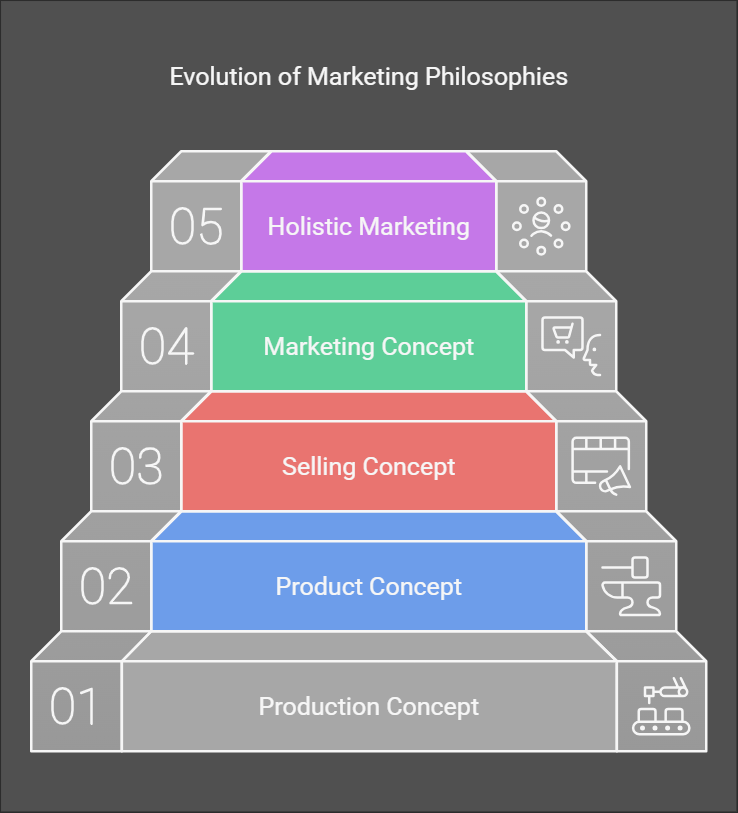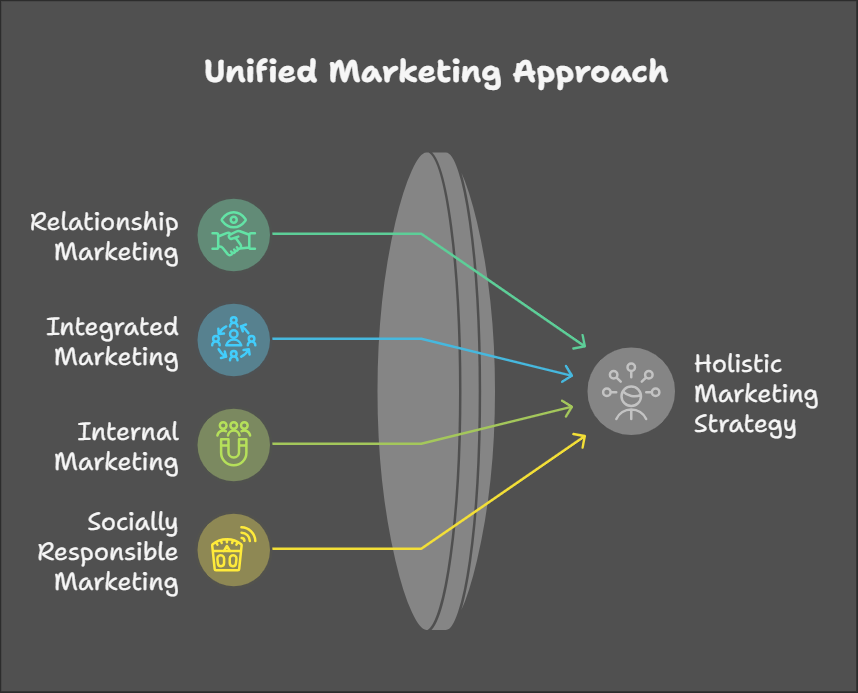Evolution of Marketing
Evolution of Marketing Philosophies
Marketing philosophies have evolved over time, reflecting changes in the marketplace, consumer behavior, and business practices. Here's a look at the key stages in this evolution:
1. The Production Concept
- Focus: High production efficiency, low costs, and mass distribution.
- Assumption: Consumers prefer products that are widely available and inexpensive.
- Example: Ford's Model T car, which was produced on a large scale to make it affordable to a mass market.
- Limitations: This concept can lead to a lack of focus on customer needs and preferences, and may not be suitable for all products or markets.
2. The Product Concept
- Focus: Product quality, performance, and innovative features.
- Assumption: Consumers favor products that offer the most in terms of quality, performance, and innovation.
- Limitations: Even a superior product may fail if it's not priced, distributed, and promoted effectively. This concept can lead to "marketing myopia" - a focus on the product itself rather than the needs it satisfies.
3. The Selling Concept
- Focus: Aggressive selling and promotion efforts.
- Assumption: Consumers will not buy enough of the company's products unless they are actively persuaded to do so.
- Application: Often used with unsought goods (products that consumers don't typically think of buying, like life insurance or cemetery plots) or when companies have overcapacity.
- Limitations: This concept can be short-sighted and may not lead to long-term customer satisfaction or loyalty.
4. The Marketing Concept
- Focus: Understanding and meeting customer needs and wants.
- Assumption: The key to achieving organizational goals is being more effective than competitors in creating, delivering, and communicating superior customer value.
- Shift: From a "make and sell" philosophy to a "sense and respond" philosophy.
-
Key Principles:
- Customer focus
- Integrated marketing effort
- Profitability
Holistic Marketing
Holistic marketing is a philosophy that emphasizes the importance of integrating all aspects of marketing into a cohesive strategy. It's about creating a unified and consistent brand experience for customers across all touchpoints.
Key Components of Holistic Marketing
-
Relationship Marketing:
- Focuses on building long-term, mutually beneficial relationships with key stakeholders, including customers, employees, partners, and the financial community.
- Aims to create a "marketing network" of loyal and engaged stakeholders who contribute to the company's success.
- Examples: Loyalty programs, customer relationship management (CRM) systems, employee empowerment initiatives.
-
Integrated Marketing:
- Coordinates all marketing activities and programs to deliver a consistent message and value proposition to customers.
- Integrates the 4 Ps of marketing (product, price, place, promotion) into a comprehensive strategy.
- Ensures that all marketing efforts work together seamlessly to achieve common goals.
- Examples: Consistent branding across all channels, integrated marketing campaigns, coordinated messaging across online and offline platforms.
-
Internal Marketing:
- Focuses on motivating and empowering employees to deliver excellent customer service and support the company's marketing efforts.
- Recognizes that employees are internal customers who need to be engaged and aligned with the company's values and goals.
- Examples: Employee training programs, internal communication initiatives, employee recognition programs.
-
Socially Responsible Marketing:
- Considers the ethical and societal impact of marketing decisions.
- Aims to balance the company's needs with the needs of customers and society as a whole.
- Examples: Sustainable marketing practices, cause-related marketing, ethical sourcing.
Core Marketing Concepts
Needs, Wants, and Demands
-
Needs: Basic human requirements or states of felt deprivation.
- Examples: Air, food, water, clothing, shelter, recreation, education.
-
Wants: When needs are directed to specific objects that might satisfy the need, shaped by culture and personality.
- Example: Food is a need, but wanting biryani or pizza is a want.
-
Demands: Wants for specific products backed by an ability to pay (buying power).
- Example: Many people desire a Rolls Royce car, but only a few can afford it.
Five Types of Needs
- Stated needs: What the customer explicitly says they want (e.g., "I want an inexpensive car").
- Real needs: The underlying need behind the stated need (e.g., "I want a car with low operating costs").
- Unstated needs: Needs the customer expects to be fulfilled without explicitly stating them (e.g., "I expect good service from the dealer").
- Delight needs: Needs that would enhance the customer's experience but are not expected (e.g., "I would like the car to have a built-in navigation system").
- Secret needs: Needs that are not expressed, often due to social or psychological reasons (e.g., "I want my friends to see me as a savvy consumer").
Market Offerings and Value Propositions
- Market Offering: A combination of products, services, information, and experiences offered to a target market to satisfy their needs.
- Value Proposition: A set of benefits that the company promises to deliver to customers to satisfy their needs.
Brands
- Brand: A name, term, design, symbol, or other feature that identifies and differentiates a company's offerings from those of competitors.
Customer Value and Satisfaction
- Customer-Perceived Value: The customer's evaluation of the difference between the benefits and costs of a market offering, relative to competing offerings.
- Customer Satisfaction: The extent to which a product's perceived performance matches or exceeds customer expectations.
Marketing Channels
- Communication channels: Deliver and receive messages from target buyers (e.g., social media, email, websites).
- Distribution channels: Display, sell, or deliver products to customers (e.g., distributors, wholesalers, retailers).
- Service channels: Facilitate transactions and provide customer support (e.g., banks, insurance agencies, transportation companies).
Supply Chain
- Supply Chain: The entire system of organizations, people, activities, information, and resources involved in moving a product or service from supplier to customer.
- Partner Relationship Management: Working closely with partners in and outside the company to create greater value for customers.
Competition
Competition is about all external forces affecting a company's ability to attract and keep customers, not just direct rivals.
Key Aspects:
- Direct Competitors: Similar products, same market (e.g., Coke vs. Pepsi).
- Indirect Competitors: Different products, same need (e.g., coffee vs. tea).
- Potential New Entrants: Possible future competitors.
- Substitute Products/Services: Alternatives satisfying the same need (e.g., email vs. mail).
- Power of Buyers: Customers' influence on prices.
- Power of Suppliers: Suppliers' influence on prices.
The Marketing Environment
The marketing environment is all internal and external factors impacting a company's marketing efforts and customer relationships.
Key Components:
-
Microenvironment: Close to the company:
- Company, Suppliers, Intermediaries, Customers, Competitors, Publics.
-
Macroenvironment: Larger societal forces:
- Demographic, Economic, Natural, Technological, Political, Cultural factors.


